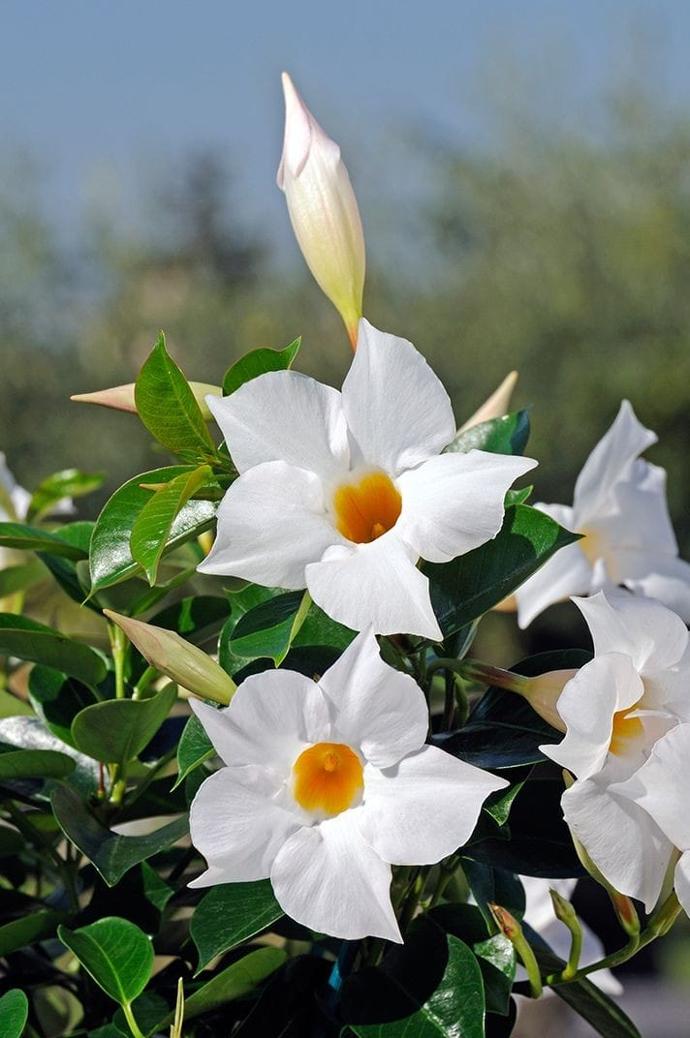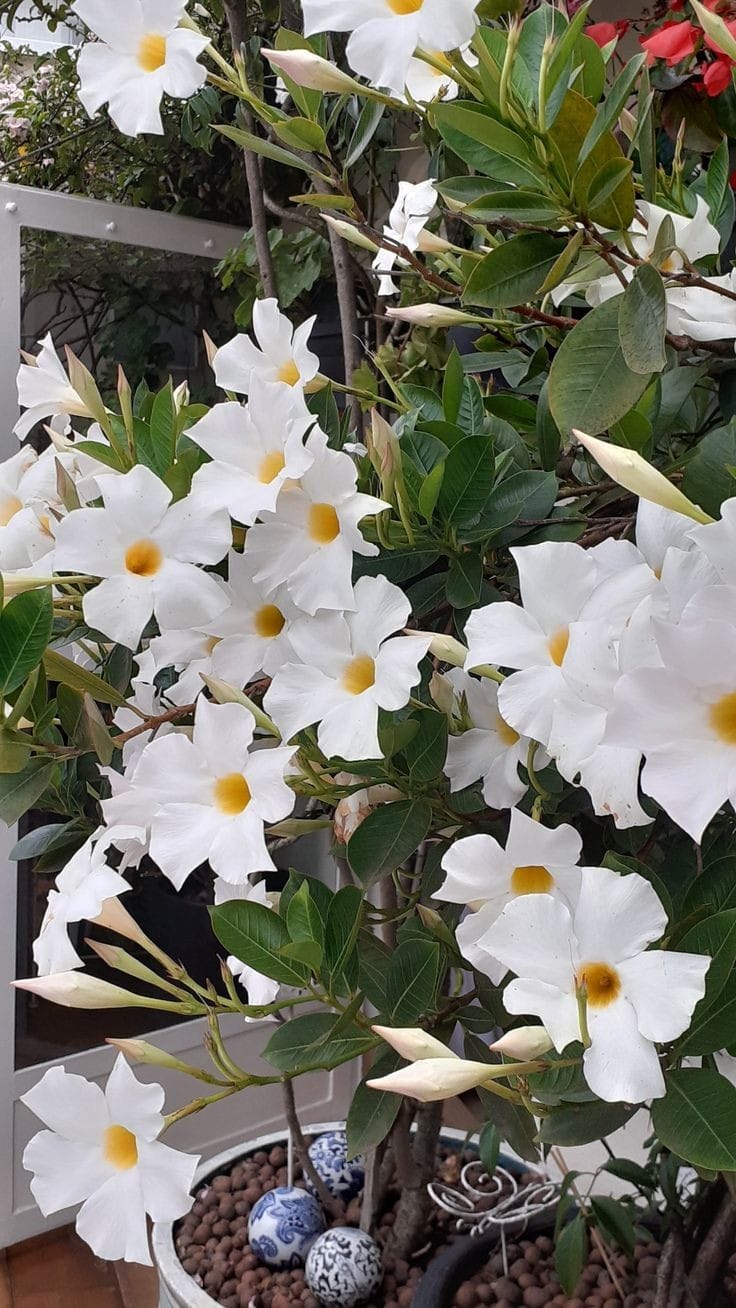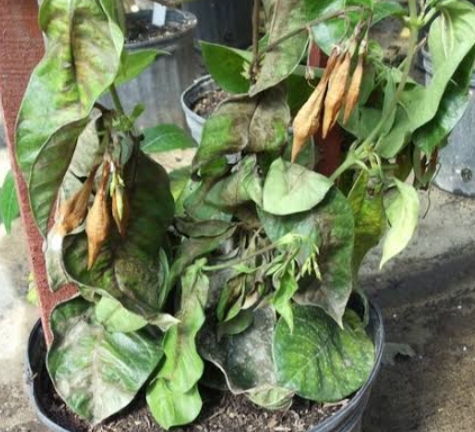Mandavillea white Plant
Mandevilla White, also known as Mandevilla splendens, is an outdoor flowering vine. Plant in well-draining soil with full sun exposure. Provide support for climbing. Water consistently, and fertilize during the growing season for optimal flower production. Pruning helps control its size. 
Habit
Climber
Height
2 to 3 m
Growth
Fast
Soil
Well-drained, Sandy Loam
Shade
Full Sun
Moisture
Moist
Edible
No
Medicinal
No
Origin
South America
Climatic Condition
Tropical, Subtropical
Temperature (°)
20°C to 30°C
Humidity (%)
60% to 80%
Potting media
50% Loam, 40% Sand, 10% Compost
Fertilizers
Organic Fertilizer
Watering
Regular watering
Plant Weight
1 to 2 kg
Flowering Time
Spring to Fall
Soil Ph level
6.0 to 7.0
Water Ph level
6.0 to 7.5
Soil EC
0.6 to 1.0 mS/cm
Yield Per Plant
5 to 10 kg per plant
NPK ratio
4:03:02
life Span
1 to 2 years
Health Benefits
Ornamental, Fragrance
Suggested Grow Media or Potting Mix ?
50% loamy soil, 30% compost, 20% sand
Suggested Fertigation/Fertilizers
Fertilize every 4 weeks with a balanced fertilizer.
Common Diseases and Remedies
Anthracnose , Pink disease
Brown spots or lesions on the leaf veins , leaf drop may occur .
discard fallen leaves on infected plants
HEALTH BENEFITS
Ornamental; no known medicinal uses.
What Is An Mandavillea White ?
Mandevillea White, also known as Mandevillea Alba, is a beautiful flowering plant with white trumpet-shaped flowers. This is a Mandevillea vine variety native to Central and South America. Commonly grown on the vine or in containers, Mandevillea White requires warm temperatures and plenty of sunlight to thrive.

What Are The Different Types Of Mandavillea White Plants?
1. Mandevillea bolibiensis
Also known as white dipladenia, this variety is characterized by white star-shaped flowers with yellow throats.
2. Mandevillea Splendens ``White Fantasy''
This variety produces large pure white flowers with a faint fragrance.
3. Mandevillea 'White Cascade'
A trailing variety with numerous clusters of white flowers, perfect for hanging baskets or as a waterfall over a wall.
4. Mandevillea Sanderi 'Bridal Bouquet'
This variety produces large fragrant white flowers with yellow centers. A popular choice for garden and container trellises and arbors.
5. Mandevillea 'Moonlight Parfait'
Known for its stunning creamy white flowers with soft pink accents, this variety adds an elegant touch to any garden or patio.

How to Care Mandavillea White Plant ?
1. Location
The ideal location for the white mandevillea plant is full sun and well-drained soil. It requires at least six hours of sunlight per day, but some afternoon shade is beneficial in hot climates. Also, Mandevillea is sensitive to cold, so make sure the temperature is between 15°C and 27°C. Whether planted in the ground or in containers, it is essential to provide a sturdy support structure for climbing varieties.
2. Sunshine
White Mandevillea plants prefer full sun to partial shade. It thrives in at least 6 hours of direct sunlight each day. However, in hot regions, providing shade in the afternoon can help protect against strong sunlight and prevent leaf burn. Overall, make sure to place your Mandevilla plant in a location where it receives plenty of sunlight and, if necessary, protection from extreme heat.
3. Soil
Mandevillea plants, including the white variety, prefer well-drained soils with a slightly acidic to neutral pH (pH 5.5 to 7.0). Sandy loam or clay soils rich in organic matter are ideal for their growth. This type of soil drains well while retaining enough moisture to keep roots healthy. Avoid waterlogged or compacted soils as this can cause root rot and other problems. If you plant your Mandevillea in a container, use a high-quality potting soil specially formulated for container gardening and ensure good drainage. Check the soil moisture regularly and water if the top of the soil feels dry.
4. Hydration
Water the plant liberally when the top inch of soil feels dry. Make sure the soil stays evenly moist and not soggy. Avoid watering in the evening to prevent excess moisture from remaining on the leaves overnight, which can cause fungal problems. Direct the water toward the base of the plant to avoid wetting the leaves. Gently attach the watering can or hose to ensure a steady watering.

5. Nourishment
Use a balanced, water-soluble fertilizer specially formulated for flowering plants. Fertilize according to the manufacturer's instructions, usually every 2 to 4 weeks during the growing season (spring through early fall). When planting, incorporate organic matter such as compost or well-rotted manure into the soil. Additionally, the soil should be fertilized with compost every year to replenish nutrients and improve soil structure.
6. Issues
Fungal diseases such as leaf spot can cause black spots or lesions on the leaves. Improve air circulation around plants, avoid overhead watering, and spray with fungicides as needed. Common pests that can affect mandevillea plants include aphids, spider mites, and whiteflies. Inspect plants regularly and use insecticidal soap or neem oil to control pests. Flowers may not bloom if there is insufficient sunlight, insufficient fertilizer, or pruning at the wrong time.
What are the Benefits of Mandavillea White ?
White flowers add elegance and beauty to any garden or landscape. Mandevillea 'White' can be grown on the vine or in containers, making it suitable for a variety of garden designs and spaces. In general, Mandevillea plants are easy to care for and require moderate watering and occasional pruning to maintain their shape. Flowers attract pollinators such as bees and butterflies, which contribute to the health of the surrounding ecosystem. Mandevillea 'White' produces profuse flowers throughout the growing season, providing continuous color and visual interest.

FAQs About Growing Mandavillea White
1. Do Mandavilleas come back every year ?
Mandavillieas are tender perennials that can survive the winter in mild climates and come back every year. In cooler climates, it is usually treated as an annual and must be re-potted every year.
2. Does Mandavillea like sun or shade ?
Mandavillea requires at least 6 hours of direct sunlight each day to grow and bloom well. However, in regions with hot summers, it is advantageous to have shade during the hottest hours of the day. Generally, morning sun and afternoon shade are suitable for mandavillea plants.
3. What growing conditions does Mandevillea White require ?
Mandevillea White grows in warm climates and prefers full sun to partial shade. Requires well-drained soil with regular watering, allowing the soil to dry slightly between waterings. In addition, it benefits from balanced fertilization and protection from strong winds during the growing season. For optimal growth, it is important to maintain temperatures above 15°C.
4. How long does Mandevillea White typically bloom ?
Mandevillea White typically blooms from late spring to early fall, depending on climate and growing conditions. If cared for properly, they can produce flowers consistently throughout the blooming period, brightening up your garden or landscape for months.
5. Does Mandevillea White have any special fertilization requirements ?
Mandevillea White promotes healthy growth and abundant flowering when fertilized regularly throughout the growing season. Use a balanced fertilizer containing equal parts nitrogen, phosphorus, and potassium (NPK) or a fertilizer specifically formulated for flowering plants. Apply fertilizer every two to three weeks during the growing season, following dosage and application instructions on the product label.


